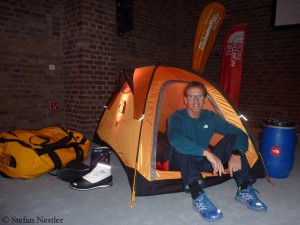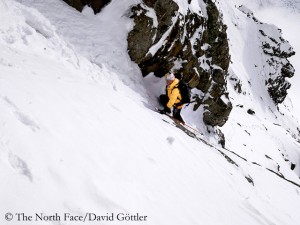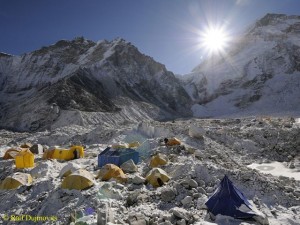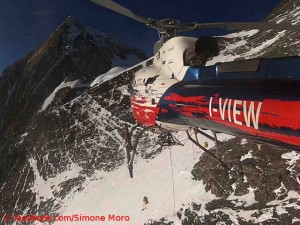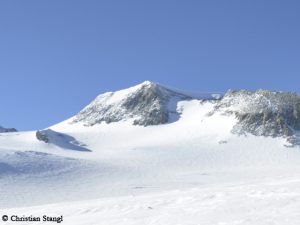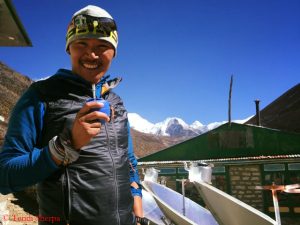Moro: “Winter climbs are pure exploration”
This man can not keep his hands off winter climbing. Simone Moro has already made three first winter ascents of eight-thousanders: Shishapangma (in 2005), Makalu (2009) and Gasherbrum II (2011). “I did twelve expeditions in winter”, the 47-year-old climber from Italy tells me when I meet him in my home town of Cologne. “In total, a lot of months.” I am curious about his new plan:
Simone, you have spent most of the last winters at eight-thousanders? What’s about the coming winter?
I am preparing a new project that is still secret. Not because I have something to hide but just because I am waiting for the climbing permit. At the beginning of the winter I had an idea, then I didn’t get the permit by the Chinese. So I had to change my plan. That is the reason why I don’t want to announce it before I’m one hundred percent sure. What I can tell you: I will start already in 2015, quite late, but still in winter.
What can you reveal? Will it be an eight-thousander? There were rumors that you would try the first winter ascent of Mount Everest from the north side.
This was one of the ideas, but not the last. It was impossible because the Chinese did not give the permit. They said that Tibet was closed for alpinists from 31 December until the end of March. Now I have more than one options, one of them is the original idea, it is still there, it is an eight-thousander. But it is not quite sure that it will be an eight-thousander because I am thinking that very soon the first page of the exploration of the eight-thousanders will be closed when Nanga Parbat and K 2 will be climbed in winter. There will be second steps like the exploration of seven- or six-thousanders which were never climbed in winter. So it will be something similar.
Did the Chinese inform you about the reason for their decision?
No.
Maybe because of your south-north-traverse of Everest in 2006, when you had to pay a fine for an illegal climb, because you had no permit for descending on the north side?
No. I went to Tibet after that date. The Chinese try to keep away foreigners as much as they can. Tourists from abroad make just ten or 15 percent, more than 85 percent of the tourists are Chinese. They don’t need climbers from abroad, especially in winter. I’m really happy that I climbed Shishapangma in winter. That was the only complete winter ascent in China so far.
There will be winter expeditions to Nanga Parbat and K2. Why didn’t you join any of them?
When I do winter expeditions I want to have the right partner. My usual partners, Denis Urubko and David Goettler, were not interested in going to Nanga Parbat again. Denis is afraid of terrorism, and David wants to stay at home this winter. There will be at least two more expeditions on Nanga Parbat, that is not what I am looking for. I don’t want to compete. So I leave the project to them. And I will not go to K 2 because I have promised my wife that I will never try K 2 in winter. She got a bad sensation, a kind of a dream, that I will die if I try K 2 in winter. She is quite good in making predictions, so I don’t want to play with that.
In winter, it’s really bloody cold and windy on eight-thousanders. What is for you the special charm of winter expeditions?
When you are attempting any Himalayan mountain in winter, you feel not simply like a mountaineer but like an explorer. You are not performing a climb, you enter the unknown. Even if you return without summit access, it’s not failure but pure exploration. Nobody around you, nothing is easy, it’s a continuing daily question mark: Am I strong enough to resist in base camp or to go to Camp 1? The mountain that you may have already climbed before in spring or summer has changed: It is completely covered by snow, no fixed ropes, no foot prints. It’s pure ancient alpinism – even if you have only a chance of ten percent to succeed and 90 percent to fail.
Simone Moro about winter climbs
And you can find loneliness on 8000ers only in winter?
Yes, for sure. The mountain that I climb in winter is exactly the same as thousand years ago. You don’t even see the retreatment of glaciers because everything turns to be white, silent, pure, wild. That is something that doesn’t exist any more in summer or spring.
Let´s come back to Everest. Do you think that the avalanche accident with 16 dead climbers last April will have a lasting impact on commercial climbing on Everest?
For sure there will be a lot of people who return to Everest. Probably some of them will go to Tibet and climb no more from the Nepalese side. Probably the tension in base camp will remain high due to the danger, due to the business that is generated by Everest. Probably they will change the climbing route and stay more in the centre or even more on the right side of the Khumbu Icefall.
You talked about the tension in base camp. In 2013, you, Ueli Steck and Jonathan Griffith were involved in a brawl at high camp which made headlines worldwide. Did you make your peace with this incident?
It is really lying behind me. I have forgiven and forgotten what happened. It was a bad moment, we all were nervous. There is no winner or loser in that fight, no person responsible or innocent, including myself. I didn’t have to say those bad words. I don’t want to continue to analyze the disproportion between the bad words and the fact that those people intended to kill me. Because if I start that game, I slightly try to make a loser and a winner or a person that is responsible and one that is not. Let’s go over, everybody! For sure the tension that is now on Everest is not the tension in 1953, because the Sherpas, and I agree with them, are not any more like donkeys carrying the heavy loads. They are not only high altitude Sherpas, but mountain guides and organizers. They organize your flight tickets from Cologne to Kathmandu, the trekking, everything. There is an evident competition with the foreign organizers. Thus the tension has to do with money. Young Sherpas work with their iPhone, with 5,000 $ salaries. They are evolving.
Simone Moro about the brawl in Everest high camp
Do you think that attitude of the western climbers must change?
Both have to change. The Sherpas have to stop showing that they are the owners of that mountain and their country, because we know that. If they do so, they want to dominate, and there is no more client-friendly attitude. On the other hand, we have to accept that we are guests. The Westerners must stop to treat the locals like the white guys did in Africa two centuries ago. Both have to reestablish the equilibrium, in the first place the Westernerst, but also some few of the Nepalese.
During the last years, you have made a lot of search and rescue flights as a helicopter pilot in the Himalayas including Everest. Do you feel now more as a climber or as a pilot?
When I’m evolving, it doesn’t mean that I’m changing. I am not leaving the ice axe, I am training even more than before. My body weight is exactly like when I was 22. And I climb exactly like when I was 33. I still consider myself a cutting-edge all-round mountaineer. But I have a parallel life. I’m just changing how I dedicate my time. In the past it was family and climbing. Now it’s family, climbing and flying. I’m flying a lot, as much as I can. I will establish a helicopter school in United States. My dream is also to train young Nepalese in my school to become mountain pilots, the best in their country. This is the way I am evolving. I feel that I am a mountaineer. And when I’m flying I am a pilot with the mentality of a mountaineer in his heart. But I’m still training like a horse. If someone saw a crazy guy today running along the river Rhine for two hours, it was me.
What do you think about the use of helicopters on Everest. Should it be allowed not only for rescue but also for transport of material and climbers?
At the moment any kind of helicopter flight on Everest is forbidden except for rescue. That is acceptable. But it should be allowed for pilots to train landing on Everest, during the off-season, like now when nobody is there. Go there and simulate, that is exactly the way of training we do here in Europe. The demand to carry alpinists and tourists up the mountain by helicopter goes too far. It’s better to remind everybody that above base camp it is always risky for the pilot, and also for the clients on board a helicopter.
Some years ago, you told me, that you could still be a good climber until 50. Now you are 47, you have three years left.
Honestly considering how much I am still motivated and , as I told you before, watching my body weight, my performance in climbing, running and so on, I can probably stand it for two more years. For sure until 52, probably also 55, I can be really on the edge of my dream, and you can expect of me some surprise in climbing and at the same time a growing surprise in helicopter. Afterwards I invite you to ask me this question again.



